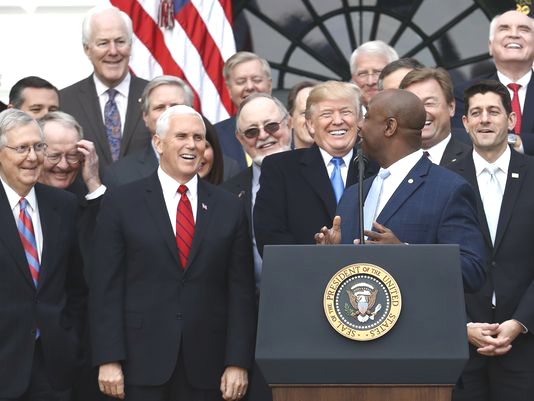DEFICIT COULD HIT $1 TRILLION OUT OF 2018, AND THAT IS BEFORE THE FULL EFFECT OF TAX REDUCTIONS
2018 could be the year the dam blasts on the government shortage.
Back in June, the Congressional Budget Office anticipated that the spending shortage — government costs surpassing incomes — would drop to $563 billion of every 2018 from the $666 billion deficit the Treasury Department pronounced in the 2017 monetary year, which finished Sept. 30.
Presently spending specialists outside government say the 2018 aggregate could surpass $1 trillion due to arrangement of bills being passed with hardly a pause in between, and choices to scrap what were at that point feeble breaking points on spending.
The assessment bundle Congress sent to President Trump will cut government incomes by $135 billion out of 2018, an assume that ascents to $280 billion out of 2019, as per the Joint Committee on Taxation.
Over that, Congress affirmed crisis catastrophe help bills totaling $15 billion in September, $36.5 billion in October, and this week is contending over adding another $81 billion to address California out of control fires and Hurricanes Harvey, Irma and Maria. Notwithstanding any very late choice to pay for it, that spending will be added to the 2018 shortfall.
Spending levels for 2018 won’t be settled until January, yet progressing transactions in Congress are centered around the amount to blow past tops on household and safeguard spending, not on the amount to cut.
“On the off chance that you include that the economy is simply not going to detonate emphatically, at that point it could without much of a stretch be more than $1 trillion, and that accept nothing terrible occurs for whatever is left of the year that costs more than we’re expecting,” said Stan Collender, a previous staff chief for the House and Senate spending boards of trustees and creator of The Guide to the Federal Budget.
Collender additionally said that loan fees would ascend because of the assessment charge, making it more costly to pay enthusiasm on the current government obligation of about $15 trillion. The elected obligation is an amassing of the yearly shortages keep running up by the legislature.
Budgetary “pay as you go” laws intended to hold spending within proper limits require that when Congress passes charges that expansion the deficiency, programmed cuts are activated in both optional and compulsory projects, for example, Medicare. Democrats have contended for a considerable length of time that the assessment bill would drive cuts in January that zero out many projects and trim $25 billion from Medicare.
Those compensation as-you-go orders can be postponed by passing another law, and that is the thing that Republican pioneers in Congress are looking at doing. They deride Democrats’ protestations about the deficiency as pretended, taking note of the shortage topped $1 trillion for quite a while when Democrat Barack Obama was president.
Be that as it may, shortfall falcons say that with the economy developing and joblessness down to 4.1%, this is the time the administration ought to be all the more financially mindful.
“When we had trillion-dollar shortages the last time, it was the consequence of one of the most exceedingly awful financial downturns we’ve found ever. This will be totally self-perpetrated,” said Maya MacGuineas, leader of the Committee for a Responsible Federal Budget. “At the point when the economy recouped, the deficiencies descended, not by enough, but rather this is the outcome absolutely of approaches, not of a retreat.
“No one is looking at paying for anything any longer,” she said.
The administration will declare the last deficiency number in mid October, half a month prior to the mid-term 2018 decisions.
Trump has ignored stresses over the shortage, indicating partnerships that have abroad resources that he accepts will be repatriated and used to extend and develop organizations in the U.S.
“It’s most likely finished $4 trillion,” Trump said on Saturday. “This is cash that has been stuck there for quite a long time, and it will return filling the province.” But the U.S. Treasury will just gather a little segment of that cash in charges.
The Trump organization and a large number of the duty bill’s supporters additionally contend the CBO accepted a 1.9% normal financial development rate over the coming decade that is too low.
“In the event that the development is … rather somewhat higher, 2.3% development throughout the following 10 years … then you will see some shortfall lessening,” Sen. Ransack Portman, R-Ohio, told columnists Wednesday. “It would rather prompt having the capacity to pay down the obligation.”
Sen. Bounce Corker, R-Tenn., at first restricted the assessment charge due to worries about expanding the national obligation. He at last voted in favor of it, saying he accepted on adjust that progressions to the corporate assessment rate would make the United States more alluring for multinational enterprises, and that open door “ought not be missed.”
Corker likewise received a contention by Trump’s Treasury Department that the duty bill would consolidate with the impact of diminished controls and changes to exchange and migration arrangement that goad the economy.
The threat, MacGuineas stated, is whether they are incorrect and the economy tanks again later on. A greater national obligation will leave the administration with less “financial capability” to react the way it did in 2008, she said.
“I wish was going on that financially dependable individuals would state, ‘Rather than postponing the tenets requiring obligatory cuts, we should supplant them with capable spending cuts or canceling some portion of the tax reduction,'” she said. “Where we are in the business cycle, we ought to see the deficiency contracting.”



Comments
Post a Comment